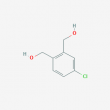
(4-Chloro-1,2-phenylene)dimethanol - 2g
Short description
(4-Chloro-1,2-phenylene)dimethanol
Discover the exceptional versatility of (4-Chloro-1,2-phenylene)dimethanol, a high-purity (95%) organic halide compound with a molecular weight of 172.6089g/mol. This clear, crystalline solid boasts a unique chemical structure, offering a wealth of potential applications in your research and development projects.
Crafted with precision, this compound's CAS number 110706-49-5 and InChI key ARSFSTVKMONOTE-UHFFFAOYSA-N ensure reliable identification and traceability. Handle with care, as it may cause skin irritation, eye irritation, and respiratory discomfort. Always store in a cool, well-ventilated area and wear appropriate personal protective equipment. Unlock the possibilities of this exceptional organic halide and elevate your experiments to new heights.
- CAS: 110706-49-5
- Molecular Formula: C8H9ClO2
- Molecular Weight: 172.6089g/mol
- Purity: 95%
- InChI Key: ARSFSTVKMONOTE-UHFFFAOYSA-N
-
Procurenet Team Tshim Sha Tsui
Hong Kong 3 years
Description
(4-Chloro-1,2-phenylene)dimethanol
Unlock the versatile potential of (4-Chloro-1,2-phenylene)dimethanol, a highly specialized chemical compound that holds the key to unlocking new frontiers in scientific research and innovation. With its unique molecular structure and exceptional purity, this Organic Halide offers a world of possibilities for researchers and chemists across diverse fields.
At the heart of this compound lies a captivating blend of chloro and phenylene moieties, seamlessly integrated to create a versatile building block for a wide range of applications. Its CAS number, 110706-49-5, serves as a distinct identifier, while the Ref # AN-AG0083HM provides a convenient reference point for those seeking to delve deeper into its technical details.
Unraveling the Compound's Potential
The chemical formula of (4-Chloro-1,2-phenylene)dimethanol, C8H9ClO2, and its molecular weight of 172.6089 g/mol, offer a glimpse into its intricate structure. With an INCHI code of InChI=1S/C8H9ClO2/c9-8-2-1-6(4-10)7(3-8)5-11/h1-3,10-11H,4-5H2 and an INCHI Key of ARSFSTVKMONOTE-UHFFFAOYSA-N, this compound can be precisely identified and tracked throughout the research and development process.
The purity of this Organic Halide, meticulously maintained at 95%, ensures reliable and consistent results in your experiments and applications. This high level of purity is a testament to the dedication and expertise of the team behind its production, making it a trusted choice for discerning researchers and scientists.
Unlocking the Potential: Key Applications
The versatility of (4-Chloro-1,2-phenylene)dimethanol extends across a wide range of scientific disciplines, offering exciting opportunities for innovation and discovery.
Pharmaceutical Research: This compound serves as a valuable building block in the synthesis of novel pharmaceutical compounds. Its unique chemical structure and properties can be leveraged to develop innovative drug candidates targeting a diverse array of health conditions, from neurological disorders to metabolic diseases.
Agrochemical Development: In the realm of agrochemicals, (4-Chloro-1,2-phenylene)dimethanol contributes to the creation of advanced crop protection agents. Its halogenated structure and specific functional groups can be harnessed to formulate potent and selective pesticides, promoting healthier crops and higher yields while minimizing environmental impact.
Material Science Innovations: Researchers in material science find (4-Chloro-1,2-phenylene)dimethanol to be a versatile compound for the development of novel materials with tailored properties. Its integration into polymers, coatings, or other advanced materials can lead to the creation of substances with enhanced mechanical strength, thermal stability, or other performance-enhancing characteristics.
Handling and Storage: Ensuring Safety and Longevity
As with any specialized chemical compound, proper handling and storage of (4-Chloro-1,2-phenylene)dimethanol are crucial to maintain its integrity and ensure the safety of those working with it. The compound is classified with hazard statements H302, H315, H319, and H335, indicating that it may be harmful if swallowed, cause skin irritation, cause serious eye irritation, and may cause respiratory irritation.
To mitigate these risks, it is essential to wear appropriate personal protective equipment, such as protective gloves, clothing, eye protection, and a face mask, when handling the compound. Additionally, work should be carried out in a well-ventilated area or outdoors to minimize exposure. In the event of accidental ingestion or skin contact, seek immediate medical assistance.
For optimal long-term storage, (4-Chloro-1,2-phenylene)dimethanol should be kept in a cool, well-ventilated environment,
Specifications
- Formula: C8H9ClO2
- H statements: H302:Harmful if swallowed.H315:Causes skin irritation.H319:Causes serious eye irritation.H335:May cause respiratory irritation.
- Inchi: InChI=1S/C8H9ClO2/c9-8-2-1-6(4-10)7(3-8)5-11/h1-3,10-11H,4-5H2
- Inchi key: ARSFSTVKMONOTE-UHFFFAOYSA-N
- Mdl: MFCD15147234
- Molecular weight: 172.6089
- Notes: Complexity : 119.Compound Is Canonicalized : Yes.Covalently-Bonded Unit Count : 1.Defined Atom Stereocenter Count : 0.Defined Bond Stereocenter Count : 0.Exact Mass : 172.029g/mol.Formal Charge : 0.Heavy Atom Count : 11.Hydrogen Bond Acceptor Count : 2.Hy
- P statements: P280:Wear protective gloves/protective clothing/eye protection/face protection.P305+P351+P338:IF IN EYES:Rinse cautiously with water for several minutes.Remove contact lenses if present and easy to do. Continue rinsing.
- Purity: 95%





